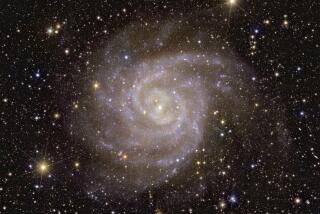Camera Lets Hubble Look Back in Time
- Share via
CAPE CANAVERAL, Fla. — Spacewalking astronauts widened the Hubble Space Telescope’s eyes to the universe Thursday by installing an advanced optical camera.
James Newman and Michael Massimino made room for the $76-million Advanced Camera for Surveys by pulling out the last of the 12-year-old Hubble’s original scientific instruments.
The new camera will allow Hubble to peer deeper into space, all the way back to some of the early phases of the universe more than 12 billion years ago, when galaxies began to form.
“You guys just paved the way for a lot of Ph.D.s in the years to come,” said astronaut Richard Linnehan, who monitored the 7 1/2-hour spacewalk from inside space shuttle Columbia.
It was the fourth--and longest--spacewalk in as many days for Columbia’s crew. One final excursion was planned for today; astronauts will attempt to repair an infrared camera that has not worked for three years.
Newman slid the new camera into Hubble on guide rails as Massimino called out the clearances for the 875-pound device, about the size of a phone booth but considerably more fragile. Within minutes, the camera was all the way in and latched down tight.
It passed its initial tests. Flight controllers in Maryland will spend the next month or two fine-tuning the instrument. Astronomers hope to begin using it by early May.
The instrument, which took five years to develop and build, is three cameras in one. It is expected to provide twice the field of view, twice the clarity and five times the sensitivity of Hubble’s current workhorse, the 8-year-old Wide Field and Planetary Camera.
“The advanced camera is going to add 10 times the capability to Hubble,” said UC astronomer Garth Illingworth, the camera’s deputy chief scientist. “So here we have a telescope that is incredibly faster, ready to move for the future.”
He described this week’s power improvements to Hubble as a tuneup on “a hot automobile.” On Thursday, he said, the astronauts put in the turbocharger.
“Hubble will detect more faint stars and galaxies during its first 18 months than have been detected with all of the previous Hubble instruments,” said Johns Hopkins University astronomer Holland Ford, who led the team that built the camera. Ford said the camera may be able to capture images of planets orbiting other nearby stars.
The camera was inserted into the slot that belonged to the Faint Object Camera, which was original equipment on Hubble in 1990 but eventually became obsolete with its 1970s technology. It was taken out of service a few years ago.






